The NVIDIA GeForce RTX 2070 Founders Edition Review: Mid-Range Turing, High-End Price
by Nate Oh on October 16, 2018 9:00 AM ESTCompute & Synthetics
Shifting gears, we'll look at the compute and synthetic aspects of the RTX 2070. Though it has its own GPU in the form of TU106, the hardware resources at hand are similar in progression to what we've seen in TU102 and TU104.
Starting off with GEMM tests, the RTX 2070's tensor cores are pulled into action with half-precision matrix multiplication, though using binaries originally compiled for Volta. Because Turing is backwards compatible and in the same compute capability family as Volta (sm_75 compared to Volta's sm_70), the benchmark continues to work out-of-the-box, though without any Turing optimizations.
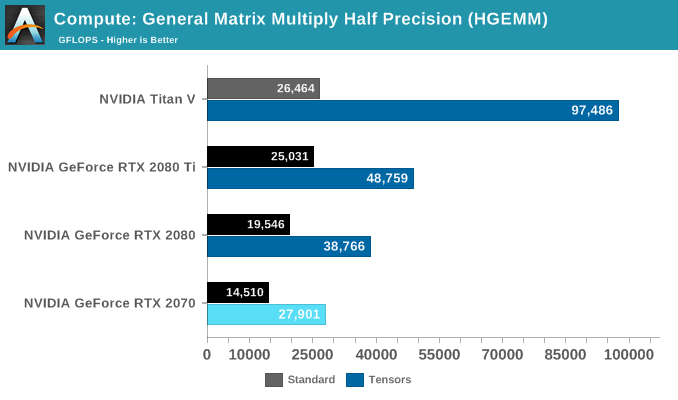
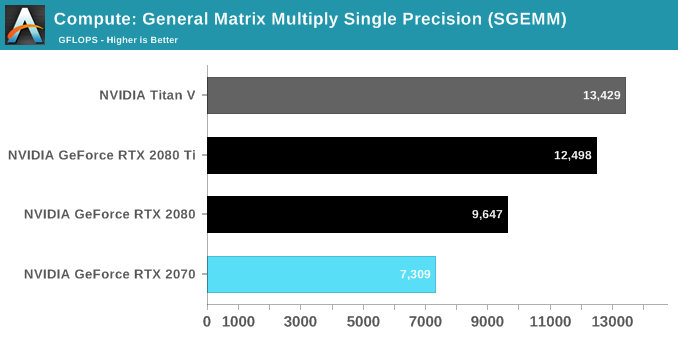
At reference specifications, peak theoretical tensor throughput is around 107.6 TFLOPS for the RTX 2080 Ti, 80.5 TFLOPS for the RTX 2080, and 59.7 TFLOPS for the RTX 2070. Unlike the 89% efficiency with the Titan V's 97.5 TFLOPS, the RTX cards are essentially at half that level, with around 47%, 48%, and 45% efficiency for the RTX 2080 Ti, 2080, and 2070 respectively. A Turing-optimized binary should bring that up, though it is possible that the GeForce RTX cards may not be designed for efficient tensor FP16 operations as opposed to the INT dot-product acceleration. After all, the GeForce RTX cards are for consumers and ostensibly intended for inferencing rather than training, which is the reasoning for the new INT support in Turing tensor cores.
In terms of SGEMM efficiency though, the RTX 2070 is hitting a ridiculous 97% of its touted 7.5 TFLOPS, though to be fair the reference specifications here are done manually rather with a reference vBIOS. The other two GeForce RTX cards are at similar 90+% levels of efficiency, though a GEMM test like this is specifically designed for maximum utilization.
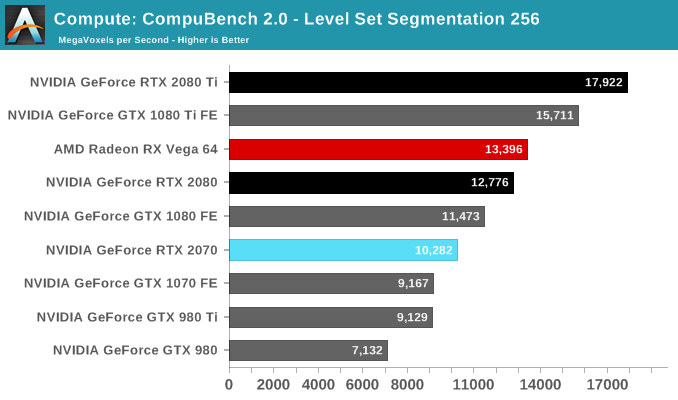
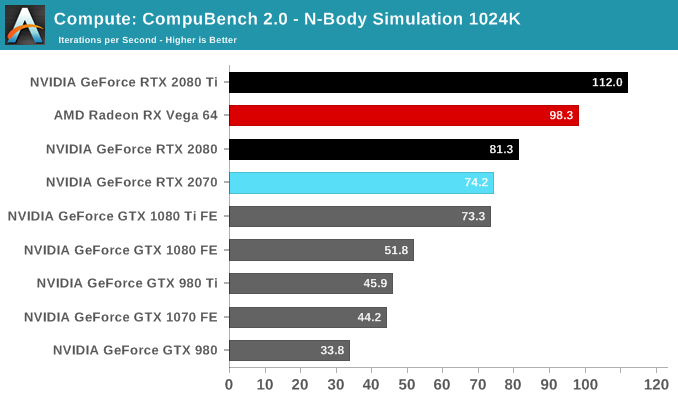
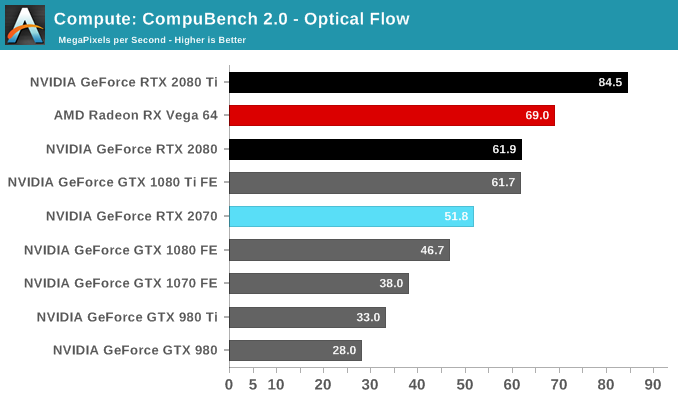
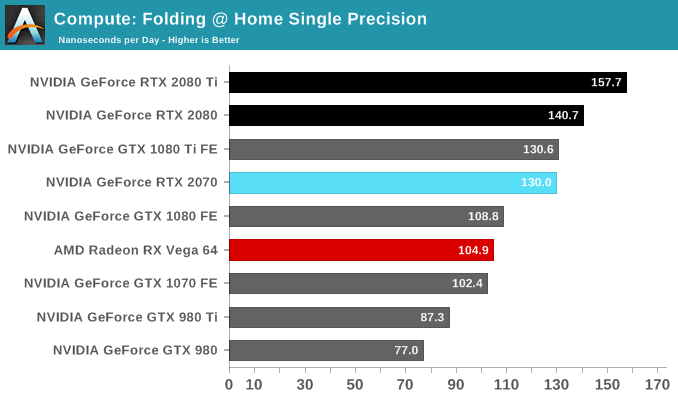
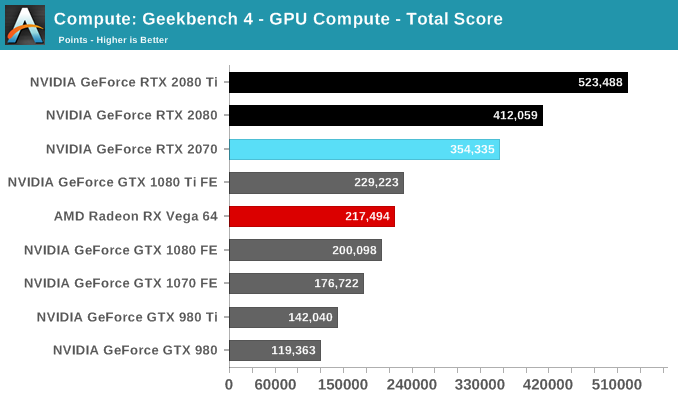
The breakdown of the GB4 subscores seems to reveal a similar uplift like we spotted with the Titan V, which had scored in excess of 509,000 points. We'll have to investigate further but Turing and Volta are clearly accelerating some of these workloads beyond what was capable in Pascal and Maxwell.
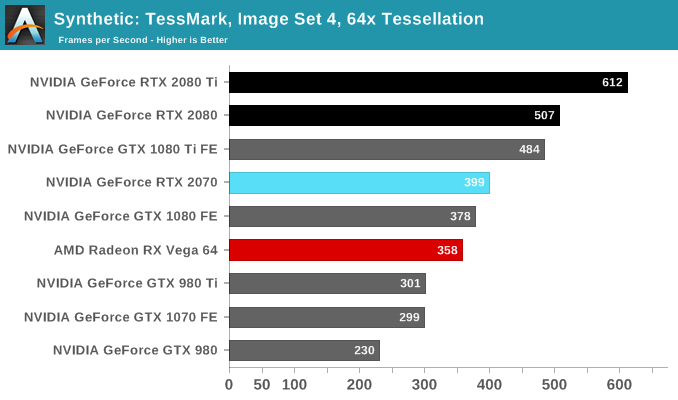
Given that TU106 has 75% of the hardware resources of TU104, the tessellation performance is in line with expectrations. For reference, we noted earlier that the Titan V scored 703 while the Titan Xp scored 604.
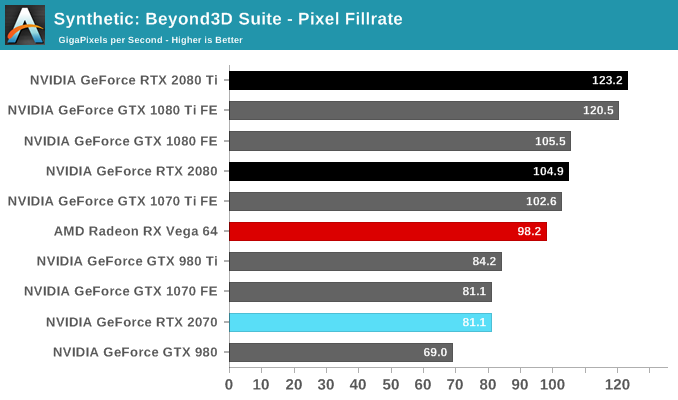
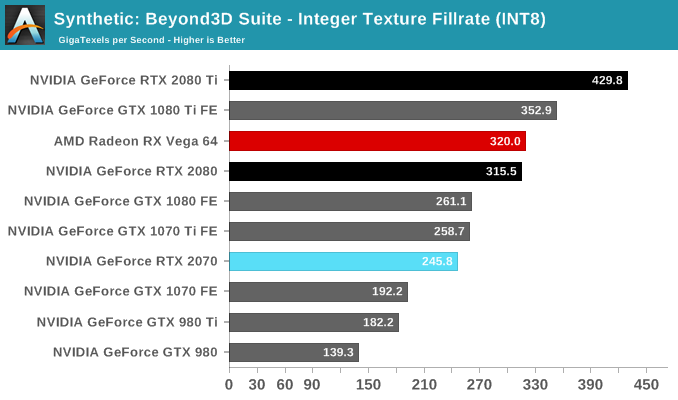










121 Comments
View All Comments
Vayra - Monday, October 22, 2018 - link
In the same vein you could say 'why get so hung up on a name to defend its a same tier card'Price matters because if perf/dollar doesn't improve there is no reason for any *buyer* to see it as a direct replacement.
Midwayman - Tuesday, October 16, 2018 - link
Why would you say that the 1080 is the card to beat and then use a garbage FE version as the benchmark comparison. Every 1080 card you're going to buy today is substantially faster than that FE version.Dr. Swag - Tuesday, October 16, 2018 - link
Because that's what they have... Plus they downclocked the founders 2070 to reference speeds too so it's not like it's that big of a deal.Midwayman - Tuesday, October 16, 2018 - link
They have tested numerous non-FE 1080 cards. The issue is that its a comparison nobody will be making when buying a 1080. It makes the 2070 look way better in the graphs than it should. If they feel the need to include a FE model for reference, fine. But they should have included a version with the faster ram and a typical factory OC since that is what is most often for sale right now. Particularly in light of the price point of the 2070.Yojimbo - Tuesday, October 16, 2018 - link
How does it make it look much better than it should when they downclocked the founder's edition to a clock below what the 3rd party 2070 cards which are comparable to the 1080s you want to use will be using.And I don't think you can use the price point of the 2070 FE or the base 2070 as a justification to include factory overclocked cards from 3rd party board partners. There are other reasons for the price differential besides price/performance in current games. And since there is a price premium for NVIDIA FE cards you're going to end up with a price comparison problem anyway.
They tested numerous non-FE 1080 cards and when they are available I'm sure they will test numerous non-FE 2070 cards. When that happens I am sure they will make the comparisons among those two sets of cards, since there will no longer be the FE/non-FE problem.
Yojimbo - Tuesday, October 16, 2018 - link
It's a difficult situation because there seems to be a dollar value to the founder's edition beyond the performance, and the reviewed card is a founder's edition.Ryan Smith - Tuesday, October 16, 2018 - link
Our editorial policy long has been (and remains) that we'll always compare products stock to stock. That means comparing a reference clocked 1070 to a reference clocked 2070, etc. This is so that we never overstate the performance of a product; as we use the reference specs, anything you buy will be as fast as our card, if not faster. As we can only loo at a finite number of cards, it continues to be the fairest and most consistent way to test cards.Plus we got a earful (rightfully) whenever we've deviated from this. You guys have made it very clear that you don't like seeing factory overclocked cards treated as any kind of baseline in a launch article.
Exodite - Tuesday, October 16, 2018 - link
Thank you Ryan!I, for one, appreciate this approach and I'm very glad to see Anandtech sticking to it.
Eletriarnation - Tuesday, October 16, 2018 - link
Pretty sure there's a mistake in the chart on the front page that puts the transistor count of the 2070 as >2x the 2080.cwolf78 - Tuesday, October 16, 2018 - link
My first PC was a Tandy 1000 RL with an Intel 8086 CPU. The first PC I ever built was a 486SX/25 and I've been a PC gamer ever since. For the first time since, well, ever, I'm seriously considering just forgoing PC gaming in the short-term. Between the ridiculous pricing of GPU's and RAM, I just don't see how this can be a hobby for the vast majority of people anymore. It's nice that you can get a lot of bang for your CPU buck these days, that doesn't even begin to make up for how much you have to bend over for the rest of it. I think I'll be getting a PS5 and call it a day and use my current PC with its OC GTX 970 for any PC exclusives I may want to play. I just can't justify spending these kind of prices. Nvidia is going to kill PC gaming for a lot of people. I'm not sure what their strategy is except to bend people over for as long and hard as they can and only then start dropping prices one sales start taking a hit. Well, sorry, Nvidia. You need to find someone else to take advantage of.